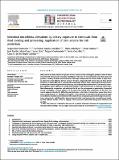Por favor, use este identificador para citar o enlazar a este item:
http://hdl.handle.net/10261/250914COMPARTIR / EXPORTAR:
 SHARE SHARE
 CORE
BASE CORE
BASE
|
|
| Visualizar otros formatos: MARC | Dublin Core | RDF | ORE | MODS | METS | DIDL | DATACITE | |

| Título: | Intestinal microbiota alterations by dietary exposure to chemicals from food cooking and processing. Application of data science for risk prediction |
Autor: | Ruiz-Saavedra, Sergio CSIC ORCID; García-González, Herminio; Arboleya, Silvia CSIC ORCID ; Salazar, Nuria CSIC ORCID; Labra-Gayo, José Emilio; Díaz, Irene CSIC; Gueimonde Fernández, Miguel CSIC ORCID ; González Solares, Sonia; González de los Reyes-Gavilán, Clara CSIC ORCID | Palabras clave: | Intestinal microbiota Colorectal cancer Diet Toxic chemicals Machine learning Semantic web |
Fecha de publicación: | 2021 | Editor: | Elsevier BV | Citación: | Computational and Structural Biotechnology Journal 19: 1081-1091 (2021) | Resumen: | Diet is one of the main sources of exposure to toxic chemicals with carcinogenic potential, some of which are generated during food processing, depending on the type of food (primarily meat, fish, bread and potatoes), cooking methods and temperature. Although demonstrated in animal models at high doses, an unequivocal link between dietary exposure to these compounds with disease has not been proven in humans. A major difficulty in assessing the actual intake of these toxic compounds is the lack of standardised and harmonised protocols for collecting and analysing dietary information. The intestinal microbiota (IM) has a great influence on health and is altered in some diseases such as colorectal cancer (CRC). Diet influences the composition and activity of the IM, and the net exposure to genotoxicity of potential dietary carcinogens in the gut depends on the interaction among these compounds, IM and diet. This review analyses critically the difficulties and challenges in the study of interactions among these three actors on the onset of CRC. Machine Learning (ML) of data obtained in subclinical and precancerous stages would help to establish risk thresholds for the intake of toxic compounds generated during food processing as related to diet and IM profiles, whereas Semantic Web could improve data accessibility and usability from different studies, as well as helping to elucidate novel interactions among those chemicals, IM and diet. | Versión del editor: | http://dx.doi.org/10.1016/j.csbj.2021.01.037 | URI: | http://hdl.handle.net/10261/250914 | DOI: | 10.1016/j.csbj.2021.01.037 | Identificadores: | doi: 10.1016/j.csbj.2021.01.037 e-issn: 2001-0370 |
| Aparece en las colecciones: | (IBFG) Artículos (IPLA) Artículos |
Ficheros en este ítem:
| Fichero | Descripción | Tamaño | Formato | |
|---|---|---|---|---|
| 1-s2.0-S2001037021000416-main.pdf | 1,62 MB | Adobe PDF |  Visualizar/Abrir |
CORE Recommender
Page view(s)
95
checked on 18-abr-2024
Download(s)
76
checked on 18-abr-2024
Google ScholarTM
Check
Altmetric
Altmetric
Este item está licenciado bajo una Licencia Creative Commons

